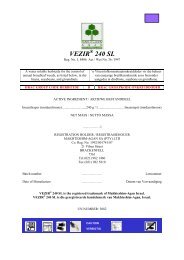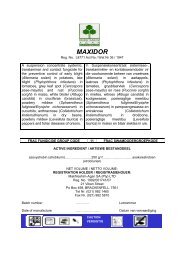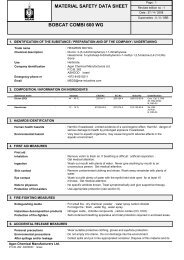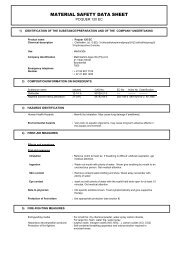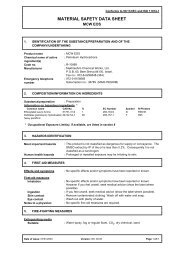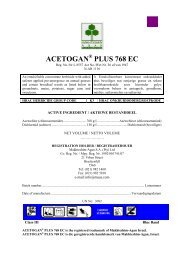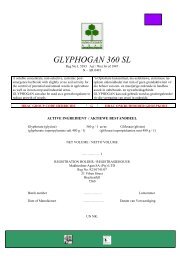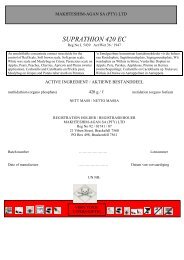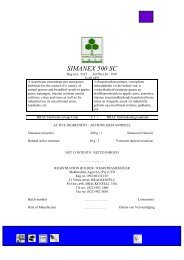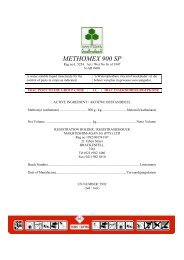SHAVIT 25 EC - Makhteshim-Agan
SHAVIT 25 EC - Makhteshim-Agan
SHAVIT 25 EC - Makhteshim-Agan
Create successful ePaper yourself
Turn your PDF publications into a flip-book with our unique Google optimized e-Paper software.
A systemic fungicide emulsifiable<br />
concentrate for the control of diseases on<br />
crops mentioned.<br />
<strong>SHAVIT</strong> <strong>25</strong> <strong>EC</strong><br />
Reg no L 5601 Act / Wet 36 / 1947<br />
‘n Sistemiese swamdoder emulgeerbare<br />
konsentraat vir die beheer van siektes op<br />
gewasse genoem.<br />
ACTIVE INGREDIENT / AKTIEWE BESTANDDEEL<br />
Triadimenol (Triazole) <strong>25</strong>0 g / l Triadimenol (Triasool)<br />
NET VOLUME / NETTO INHOUD<br />
………………<br />
REGISTRATION HOLDER / REGISTRASIEHOUER<br />
MAKHTESHIM-AGAN SA (PTY) LTD<br />
Reg no 1992/001741/07<br />
21 Viben Street<br />
Po Box 498, Brackenfell 7560<br />
Tel no (021) 982 1460<br />
Fax no (021) 982 5810<br />
Batch number …………… Lotnommer<br />
Date of Manufacture ……………. Datum van Vervaardiging<br />
(yellow / geel )<br />
HARMFULL<br />
SKADELIK
WARNINGS<br />
ALLOW 14 DAYS ON WINE AND TABLE GRAPES 3 DAYS ON PEAS AND 56 DAYS<br />
ON SOYA BEANS BETWEEN LAST APPLICATION AND HARVEST.<br />
WARNING AGAINST RESISTANCE: <strong>SHAVIT</strong> <strong>25</strong> <strong>EC</strong> is a demethylation inhibiting<br />
(DMI) fungicide recommended for the control of plant diseases. Repeated exclusive use of<br />
<strong>SHAVIT</strong> <strong>25</strong> <strong>EC</strong> may lead to a build-up of resistant strains of fungi resulting in a loss of<br />
disease control. If treatment is not effective following the use of <strong>SHAVIT</strong> <strong>25</strong> <strong>EC</strong> as<br />
recommended, a resistant strain may be present. If a DMI-resistant strain is positively<br />
identified, consideration should be given to prompt use of non-DMI fungicides. A spray<br />
programme of mixtures or alterations with non-DMI fungicides may delay resistant strain<br />
build-up.<br />
• Poisonous when swallowed, absorbed through the skin or inhaled.<br />
• Toxic to fish and wild life.<br />
• Store in a cool place away from food and feed.<br />
• Keep out of reach of children, uninformed persons and animals.<br />
Although this remedy has been extensively tested under a large variety of conditions the<br />
registration holder does not warrant that it will be efficacious under all conditions<br />
because the action and effect thereof may be affected by factors such as abnormal soil,<br />
climatic and storage conditions, quality of dilution water, compatibility with other<br />
substances not indicated on the label and the occurrence of resistance of the disease<br />
against the remedy concerned as well as by the method, time and accuracy of<br />
application. The registration holder furthermore does not accept responsibility for<br />
damage to crops, vegetation, the environment or harm to man or animal or for lack of<br />
performance of the remedy concerned due to failure of the user to follow label<br />
instructions or to the occurrence of conditions which could not have been foreseen in<br />
terms of registration.<br />
Consult the supplier in the event of any uncertainty.<br />
PR<strong>EC</strong>AUTIONS<br />
• Do not inhale fumes or spray mist.<br />
• Wash contaminated clothing daily.<br />
• Wash with soap and water after use.<br />
• Do not eat, drink or smoke while mixing, applying or before washing hands and face.<br />
• Clean spray equipment after use, dispose of wash water where it will not contaminate<br />
crops, grazing, rivers and dams.<br />
• Rinse empty container three times with a volume of water equal to a minimum of<br />
10% of that of the container. Add the rinsings to the contents of the spray tank.<br />
• Destroy empty container by perforation and never use for any other purpose.<br />
• Avoid drift of spray to other crops, grazing, rivers, dams and areas that will not be<br />
treated.<br />
• Prevent contamination of food, feeds, drinking water and eating utensils.<br />
SYMPTOMS OF HUMAN POISONING<br />
Possible symptoms of human poisoning if product is swallowed are nausea, vomiting,<br />
stomach ache and diarrhea. If product comes into contact with the eyes, it can cause irritation<br />
leading to redness and tears.
FIRST AID TREATMENT<br />
• Inhalation: Remove victim to fresh air. Consult a physician in the event of any<br />
complaints.<br />
• Ingestion: Induce vomiting by tickling the back part of the throat. Wash mouth with<br />
water. Never give anything by mouth to an unconscious person. Get medical<br />
attention.<br />
• Skin contact: Remove contaminated clothing and wash contaminated body areas with<br />
soap and water.<br />
• Eye contact: Wash off with plenty of clean running water for at least 15 minutes. If<br />
pain persists, consult a physician.<br />
NOTE TO PHYSICIAN<br />
There is no specific antidote. Treat symptomatically and give supportive therapy.<br />
If ingested perform gastric lavage and administer activated charcoal.<br />
DIR<strong>EC</strong>TIONS FOR USE: USE ONLY AS DIR<strong>EC</strong>TED<br />
Compatibility<br />
<strong>SHAVIT</strong> <strong>25</strong> <strong>EC</strong> can be used on grapes in tank mixtures with fungicides and insecticides in<br />
the wettable powder form. Tank mixtures of <strong>SHAVIT</strong> <strong>25</strong> <strong>EC</strong> with other emulsifiable<br />
concentrates in grapes are not recommended except with UNDEN (L1077), FOLIMAT<br />
(L2316), CYMBUSH (L1715) and BAYTHROID (L3017). Allow 7 days between the<br />
application of <strong>SHAVIT</strong> <strong>25</strong> <strong>EC</strong> and emulsifiable not listed above and do not apply<br />
<strong>SHAVIT</strong> <strong>25</strong> <strong>EC</strong> in combination with wetter-stickers or as a tank mixture with trace or macroelement<br />
sprays in vines.<br />
MIXING<br />
Pour the required volume of <strong>SHAVIT</strong> <strong>25</strong> <strong>EC</strong> into the water in the spray tank while agitating.<br />
Do not allow the <strong>SHAVIT</strong> <strong>25</strong> <strong>EC</strong> spray mixture to stand any length of time before using. Do<br />
not use brackish water.<br />
Aerial application:<br />
Aerial application of <strong>SHAVIT</strong> <strong>25</strong> <strong>EC</strong> may only be done by a registered Aerial Application<br />
Operator using a correctly calibrated, registered aircraft according to the instructions of SABS<br />
Code 0118 (Aerial Application of Agricultural Pesticides). Ensure that the spray mixture is<br />
distributed evenly over the target area and that the loss of spray material during application is<br />
restricted to a minimum. It is therefore essential that the following criteria be met:<br />
• Volume: A spray mixture volume of 30 to 40 litres per hectare is recommended. As this<br />
product has not been evaluated at a reduced volume rate, the registration holder cannot<br />
guarantee efficacy, or be held responsible for any adverse effects if this product is applied<br />
aerially at a lower volume rate than recommended above.<br />
• Droplet coverage: 30 to 45 droplets per cm² must be recovered at the target area.<br />
• Droplet size: A droplet spectrum with a VMD of 280 to 300 microns is recommended.<br />
Limit the production of fine droplets less than 150 microns (high drift and evaporation<br />
potential) to a minimum.<br />
• Flying height: Maintain the height of the spray boom at 3 to 4 metres above the target.<br />
Do not spray when aircraft dives, is in a climb or when banking<br />
• Use suitable atomising equipment that will produce the desired droplet size and coverage,<br />
but which will ensure the minimum loss of product. The spraying system must produce a<br />
droplet spectrum with the lowest possible Relative Span.
• Position all the atomisers within the inner 60 to 75 % of the wingspan to prevent droplets<br />
from entering the wingtip vortices.<br />
• The difference in temperature between the wet and dry bulb thermometers, of a whirling<br />
hygrometer, should not exceed 8°C.<br />
• Stop spraying if the wind speed exceeds 15 km/h.<br />
• Stop spraying under turbulent, unstable and dry conditions during the heat of the day.<br />
• Spraying under temperature inversion conditions (spraying in or above the inversion<br />
layer) and/or high humidity conditions (relative humidity 80 % and above) may lead to<br />
the following:<br />
a) reduced efficacy due to suspension and evaporation of small droplets in the air<br />
(inadequate coverage).<br />
b) damage to other sensitive crops and/or non-target areas through drifting of the<br />
suspended spray cloud away from the target field.<br />
• Ensure that the Aerial Spray Operator knows exactly which fields to spray.<br />
• Obtain an assurance from the Aerial Spray Operator that the above requirements will be<br />
met and that relevant data will be compiled in a logbook and kept for future reference.<br />
CROP / DISEASE DOSAGE RATE REMARKS<br />
TABLE GRAPES<br />
Powdery mildew<br />
(Oidium tuckeri)<br />
WINE GRAPES<br />
Powdery Mildew<br />
(Oidium tuckeri)<br />
High volume application<br />
10 – 14 day programme-20 ml /<br />
100 l water (50ml – 300ml/ha)<br />
18 – 21 day programme – 30 ml /<br />
100 l water (75 – 450 ml/ha)<br />
10 – 14 day programme – 20 ml /<br />
100 l water (50 ml – 300 ml / ha)<br />
18 – 21 day programme – 30 ml /<br />
100 l water (75 – 450 ml / ha)<br />
Commence applications when shoots are ± 10<br />
cm long and repeat at intervals as indicated.<br />
NOTE: On table grape cultivars highly<br />
susceptible to powdery mildew eg, Waltham<br />
Cross, or during periods of high infection<br />
pressure, application to be made on a 14 day<br />
programme at 30 ml / 100 l water.<br />
Commence applications when shoots are ±<br />
10 cm long and repeat as indicated.<br />
NOTE: When using the 18 – 21 day<br />
programme and periods of high infection<br />
pressure occur, switch to the 10 – 14 day<br />
programme.<br />
NOTE: High volume application: Spray to point of run-off depending on leaf area present. <strong>25</strong>0 – <strong>25</strong>00 liter<br />
spray mixture / ha.<br />
MANGOES<br />
Powdery Mildew<br />
(Oidium mangiferae)<br />
PEAS<br />
Powdery Mildew<br />
(Erysiphe pisi)<br />
20 ml / 100 l water Commence application at first signs of<br />
infection and repeat at intervals of 10 – 14<br />
days up to 100% petal drop. Usually the first<br />
application takes place when 50% of the<br />
flowers are open. This is then followed by a<br />
further 2-3 sprays depending on weather<br />
conditions and uniformity of the flowering<br />
period. Apply as a high volume spray and<br />
ensure thorough coverage of the flower<br />
Ground application<br />
1<strong>25</strong> ml / ha in 500 l water<br />
Aerial application<br />
1<strong>25</strong> ml / ha in 40 l water. Add<br />
CITOWETT at 20 ml / 100 l<br />
spray mixture.<br />
panicles.<br />
Spray as soon as first symptoms are noticed.<br />
Repeat application at intervals of 10-14 days
NOTE: <strong>SHAVIT</strong> <strong>25</strong> <strong>EC</strong> can also be applied at above mentioned rates through a center pivot irrigation system.<br />
Maximum output per application may not exceed 3 mm water. Only suitable systems with accurately<br />
calibrated chemical injectors may be used.<br />
COFFEE<br />
Rust<br />
(Hemileia vastatrix)<br />
SOYA BEANS<br />
Soyabean Rust<br />
(Phakopsera pachyrhizi)<br />
50 ml / 100 l water (500 ml / ha in<br />
1000 l water / ha)<br />
Ground application<br />
500 ml / ha<br />
Aerial application<br />
6<strong>25</strong> ml / ha<br />
Commence spraying at first sign of infection<br />
(early December), to be followed by a 2 nd<br />
spray at first signs of reinfection<br />
(approximately 4 – 6 weeks later) Further<br />
spray later in the season may only be<br />
necessary if weather conditions are<br />
conductive to rust infection. Ensure complete<br />
coverage.<br />
Apply at first signs of disease and repeat 14 –<br />
21 days later. If weather conditions favour<br />
disease development (temperatures of 15 -<br />
28°C and high humidity) use shorter interval.<br />
If the disease appears during flowering or<br />
early pod-fill more than one spray may be<br />
necessary. Should disease appear late in the<br />
growing season, a single application will be<br />
sufficient. Ensure thorough coverage of the<br />
whole plant.<br />
Use at least 200 – 400 l water / ha.<br />
See the above mentioned remarks. Use in at<br />
least 30 l water, but preferably 40 l water per<br />
ha.
WAARSKUWINGS:<br />
LAAT 14 DAE TOE OP WYN EN TAFEL DRUIWE ,3 DAE OP ERTJIES EN 56 DAE OP<br />
SOJABONE TUSSEN LAASTE TOEDIENING EN OES.<br />
WAARSKUWINGS TEEN BESTANDHEID: <strong>SHAVIT</strong> <strong>25</strong> <strong>EC</strong> is ‘n demetilasie<br />
inhiberende (DMI) swamdoder wat aanbeveel word vir die beheer van plantsiektes.<br />
Herhaalde eksklusiewe gebruik van <strong>SHAVIT</strong> <strong>25</strong> <strong>EC</strong> mag lei tot die opbou van bestande rasse<br />
van swamme en gevolglike verlies in siektebeheer. Indien behandeling nie suksesvol is nie<br />
na die toediening van <strong>SHAVIT</strong> <strong>25</strong> <strong>EC</strong> soos aanbeveel, mag ‘n bestande ras van die swam<br />
teenwoordig wees. Indien ‘n DMI-bestande ras positief geidentifiseer word moet oorweging<br />
onmiddelik gegee word aan die gebruik van nie-DMI swamdoders. ‘n Spuitprogram met<br />
mengsels of afwisselende bespuitings met nie-DMI swamdoders mag die opbou van bestande<br />
rasse vertraag.<br />
• Giftig wanneer ingesluk, geabsorbeer deur die vel of ingeasem word.<br />
• Toksies vir vis en wild.<br />
• Stoor op ‘n koel plek weg van voedsel en veevoer.<br />
• Hou buite bereik van kinders, troeteldiere of oningeligte persone.<br />
Alhoewel hierdie middel omvattend onder ‘n groot verskeidenheid toestande getoets is<br />
waarborg die registrasiehouer nie dat dit onder alle toestande doeltreffend sal wees nie,<br />
aangesien die werking en effek daarvan beinvloed kan word deur faktore soos<br />
abnormale grond-, klimaats – en bergingstoestande, kwaliteit van verdunningswater,<br />
verenigbaarheid met ander stowwe wat nie op die etiket aangedui is nie en die voorkoms<br />
van weerstand van die siekte teen die betrokke middel sowel as die metode, tyd en<br />
akkuraatheid van toediening. Verder aanvaar die registrasiehouer nie<br />
verantwoordelikheid vir die skade aan gewasse, plantegroei, die omgewing of vir<br />
nadelige effek op die mens of diere of vir ‘n gebrek aan prestasie van die betrokke<br />
middel as gevolg van die versuim van die gebruiker om etiketaanwysings na te kom of<br />
as gevolg van die ontstaaan van toestande wat nie kragtens die registrasie voorsien kon<br />
word nie. Raadpleeg die verskaffer of registrasiehouer in die geval van enige<br />
onsekerheid.<br />
VOORSORGMAATREëLS:<br />
• Voorkom inaseming van swamdoder dampe of spuitnewel.<br />
• Was gekontamineerde klere daagliks.<br />
• Was na gebruik met seep en water.<br />
• Moenie eet, drink of rook tydens vermening, toediening, of voordat hande en gesig<br />
gewas is nie.<br />
• Maak spuittoerusting na gebruik skoon en moenie waswater na plekke laat afloop<br />
waar dit oesgewassse, weidings, riviere of damme kan besoedel nie.<br />
• Spoel leë houer driekeer uit met ‘n volume water gelystaande aan ‘n minimum van<br />
10% van die houer. Gooi die spoelwater by die inhoud van die spuittenk voordat die<br />
houer op die voorgeskrewe wyse vernietig word.<br />
• Vernietig leë houer en moenie vir ander doeleindes gebruik nie.<br />
• Voorkom wegdrywing van sproeinewel na ander gewasse, weidings, riviere, damme<br />
en ander areas wat nie behandel word nie.<br />
• Voorkom kontaminasie van voedsel, voer, drinkwater of eetgerei.
SIMPTOME VAN MENSLIKE VERGIFTIGING:<br />
Moontlike simptome van menslike vergiftiging as produk ingeneem word, is naarheid,<br />
braking, maagpyn en diareè. Indien die produk in die oë beland, kan dit erge irritasie<br />
veroorsaak wat daartoe kan lei dat die oë rooi word en traan.<br />
NOODHULP:<br />
• Inaseming: Neem die pasient na vars lug. Raadpleeg die geneesheer indien enige<br />
ongemak voorkom.<br />
• Inname: Veroorsaak braking deur die agterkant van die keel te kielie. Was die mond<br />
met water uit. Moet nooit enige iets per mond aan ‘n bewustelose persoon gee nie.<br />
Raadpleeg ‘n geneesheer.<br />
• Vel: Verwyder besoedelde klere en was besoedelde liggaamsdele met water en seep.<br />
• Oë: Spoel oë vir ten minste 15 minute met skoon lopende water uit. Indien ongemak<br />
voortduur, raadpleeg ‘n geneesheer.<br />
NOTA AAN DIE GENEESHEER:<br />
Daar is geen spesifieke teenmiddel nie. Behandel simptomaties en gee ondersteunende<br />
terapie. Indien ingeneem , spoel die maag en gee ge-aktiveerde houtskool.<br />
GEBRUIKSAANWYSINGS: GEBRUIK SLEGS SOOS AANGEDUI<br />
Mengbaarheid:<br />
<strong>SHAVIT</strong> <strong>25</strong> <strong>EC</strong> kan op wingerd as tenkmengsels gebruik word met benatbare poeier<br />
swamdoders en insekdoders. Tenkmengsels van <strong>SHAVIT</strong> <strong>25</strong> <strong>EC</strong> met emulsifiseerbare<br />
konsentrate op druiwe word nie aanbeveel nie, behalwe UNDEN (L 1077), FOLIMAT (L<br />
2316), CYMBUSH (L 1715) en BAYTHROID (L 3017). Laat ‘n 7 dae periode toe in die<br />
geval van <strong>SHAVIT</strong> <strong>25</strong> <strong>EC</strong> toediening en ander emulsifiseerbare konsentrate wat nie hierbo<br />
gelys is nie. Moenie <strong>SHAVIT</strong> <strong>25</strong> <strong>EC</strong> kombineer met benattingsmiddels, of gebruik as ‘n<br />
tenkmengsel met spoorelemente of makro elemente op wingerd nie.<br />
MENGINSTRUKSIES:<br />
Voeg die vereiste volume <strong>SHAVIT</strong> <strong>25</strong> <strong>EC</strong> by die water in die spuittenk, terwyl dit geroer<br />
word. Moenie toelaat dat <strong>SHAVIT</strong> <strong>25</strong> <strong>EC</strong> spuitmengsel oorstaan voor gebruik nie. Moenie<br />
brak water gebruik nie.<br />
Lugtoediening:<br />
<strong>SHAVIT</strong> <strong>25</strong> <strong>EC</strong> kan slegs deur ‘n geregistreerde Lugbespuitingsperateur met ‘n korrek<br />
gekalibreerde, geregistreerde vliegtuig volgens die instruksies van SABS Kode 0118 (Aerial<br />
Application of Agricultural Pesticides) uit die lug bespuit word. Verseker dat die<br />
spuitmengsel eweredig oor die teikenarea versprei word, en die verlies aan spuitmengsel<br />
tydens toediening tot ‘n minimum beperk word. Dit is daarom belangrik om aan die volgende<br />
vereistes te voldoen:<br />
• Volume: ‘n Spuitmengsel volume van 30 tot 40 liter per ha word aanbeveel. Hierdie<br />
produk is nie teen ‘n verlaagde volume getoets nie. Die registrasiehouer kan nie<br />
effektiteit waarborg, of verantwoordelik gehou word vir enige nadelige effekte indien<br />
hierdie produk teen ‘n laer volume, as hierbo aanbeveel, toegedien word nie.
• Druppel bedekking: 30 tot 45 druppels per cm² moet op die teikenarea herwin word.<br />
• Druppelgrootte: ‘n Druppelspektrum met ‘n VMD van 280 tot 300 mikrons word<br />
aanbeveel. Beperk die produksie van druppels kleiner as 150 mikrons (hoë drywing<br />
en verdampingspotensiaal) tot ‘n minimum.<br />
• Vlieghoogte: Handhaaf die hoogte van die spuitbalk bo die teiken op 3 tot 4 meter.<br />
Moet nie spuit wanneer die vliegtuig duik nie, uitklim of draai nie.<br />
• Gebruik geskikte atomiseringsapparaat wat die vereiste druppelgrootte en bedekking<br />
sal produseer, maar die minste verlies van produk verseker. Die spuitstelsel moet ‘n<br />
druppelspektrum met die kleinste moontlike Relatiewe Span produseer.<br />
• Plaas al die atomiseerders in die binnste 60 tot 75 % van die vlerkspan om te verhoed<br />
dat druppels binne-in die vlerkpuntvorteks beweeg.<br />
• Die verskil in temperatuur tussen die nat- en droëboltermometer van ‘n<br />
swaaihigrometer, moet nie 8°C oorskry nie.<br />
• Stop bespuiting indien die windspoed 15 km/h oorskry.<br />
• Stop bespuiting tydens turbulente, onstabiele en droë toestande gedurende die hitte<br />
van die dag.<br />
• Bespuiting onder temperatuur inversie toestande (deur bo of binne die inversie laag te<br />
spuit) en/of hoë lugvog toestande (relatiewe humiditeit 80% en meer) mag tot<br />
volgende probleme aanleiding gee:<br />
a) verlaagde effektiwiteit aangesien die druppels as ‘n wolk in die lug bly hang en<br />
moontlik verdamp (onvoldoende bedekking op teiken).<br />
b) skade aan nie-teiken gewasse of sensitiewe areas as gevolg van wegdrywing van die<br />
spuitwolk na nie-teiken area.<br />
• Verseker dat die Lugbespuitingsoperateur presies weet watter lande bespuit moet<br />
word.<br />
• Dit is noodsaaklik om ‘n versekering van die Lugbespuitingsoperateur te verkry dat<br />
aan al die bogenoemde vereistes voldoen sal word en dat data van belang in ‘n<br />
logboek saamgevat is vir toekomstige verwysing.<br />
TOEDIENINGSHOEVEELHEDE:<br />
GEWAS / SIEKTE DOSIS OPMERKINGS<br />
TAFELDRUIWE<br />
Poeieragtige skimmel<br />
(Oidium tuckeri)<br />
WYNDRUIWE<br />
Poeieragtige skimmel<br />
(Oidium tuckeri)<br />
Hoë volume toedienings:<br />
10 – 14 dae programme – 20 ml /<br />
100 l water (50-300 ml / ha)<br />
10 – 14 dae programme – 20 ml /<br />
100 l water (50 ml – 300 ml / ha)<br />
18 – 21 dae programme 30 ml /<br />
100 l water (75 – 450 ml / ha)<br />
Begin toedienings wanneer lote ± 10 cm lank is en<br />
herhaal met tussenposes soos aangedui.<br />
NOTA: Tafeldruif kultivars wat hoogvatbaar vir<br />
poeieragtige skimmel, bv. Waltham Cross, of<br />
gedurende lang periodes van ‘n hoë infeksie druk<br />
is, moet met die 14 dae programme teen 30 ml /<br />
100 l water bespuit word.<br />
Begin toediening wanneer lote ± 10 cm lank is en<br />
herhaal soos aangedui.<br />
NOTA: Indien die 18 – 21 dae program gebruik<br />
word en periodes van hoë infeksiedruk voorkom,<br />
skakel oor na die 10 – 14 dae program.<br />
NOTA: Hoë volume toediening: Spuit tot by punt afloop afhangende van blaar oppervlak teenwoordig. <strong>25</strong>0 – <strong>25</strong>00<br />
liter spuitmengsel.
MANGOES<br />
Poeragtige skimmel<br />
(Oidium mangiferae)<br />
ERTJIES<br />
Poeieragtige skimmel<br />
(Erysiphe pisi)<br />
20 ml / 100 l water Begin toedien by eerste tekens van besmetting en<br />
herhaal elke 10 – 14 dae tot by 100%<br />
blomblaarval. Gewoonlik is die eerste toediening<br />
by 50% blom. Dit word opgevolg deur 2 – 3<br />
bespuitings afhangende van weerstoestande en<br />
uniformiteit van blomperiode. Dien toe as ‘n hoë<br />
volume toediening en verseker bedekking van alle<br />
blomgedeeltes.<br />
Grondtoediening:<br />
1<strong>25</strong> ml / ha in 500 l water<br />
Lugtoediening:<br />
1<strong>25</strong> ml / ha in 40 l water. Voeg<br />
CITOWETT by teen 20 ml / 100 l<br />
spuitmengsel.<br />
Spuit sodra eerste simptome verskyn. Herhaal<br />
toedienings met 10 – 14 dae tussenposes.<br />
NOTA: <strong>SHAVIT</strong> <strong>25</strong> <strong>EC</strong> kan ook deur ‘n sentrale besproeiings sisteem toegedien word. Maksimum lewering per<br />
toediening moenie meer meer as 3 mm water wees nie. Alleen geskikte sisteme met akkuraat geklibreerde chemiese<br />
inspuiters moet gebruik word.<br />
KOFFIE<br />
Bruinroes<br />
(Hemileia vastatrix)<br />
SOJABONE<br />
Sojaboonroes<br />
(Phakopsera pachyrhizi)<br />
50 ml / 100 l water (500 ml / ha in<br />
1000 l water)<br />
Grondtoediening:<br />
500 ml / ha<br />
Lugtoediening:<br />
6<strong>25</strong> ml / ha<br />
Begin toedienings by eerste tekens van infeksie,<br />
gevolg deur ‘n tweede bespuiting by enige<br />
reinfeksie (± 4 – 6 weke later.) Verdere<br />
bespuitings mag nodig wees as weerstoestande<br />
gunstig is vir besmetting. Verseker goeie<br />
bedekking.<br />
Dien toe sodra die eerste simptome verskyn en<br />
herhaal bespuiting 14 – 21 dae later. Wanneer<br />
weerstoestande bevorderlik is vir ontwikkeling<br />
van die siekte (temperature van 15 - 28°C en hoë<br />
vogtigheid) spuit teen korter interval. Indien die<br />
siekte gedurende blom of vroeë peulvul voorkom<br />
sal meer as een bespuiting per seisoen nodig wees.<br />
Indien die siekte laat in die groeiseisoen voorkom<br />
sal een bespuiting voldoende wees. Verseker<br />
deeglike bedekking van die hele plant.<br />
Gebruik in ten minste 30 l water maar verkieslik<br />
40 l water per ha.



